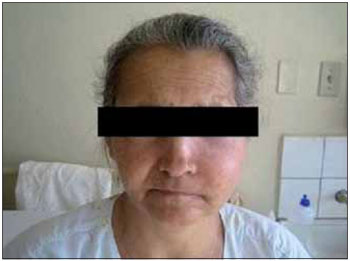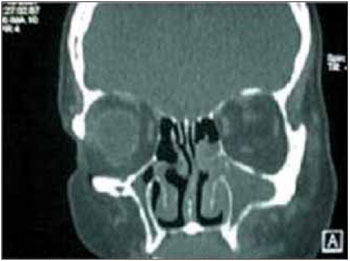INTRODUCTIONThe primary nasal lymphoma is an uncommon extranodal tumor and represents 0.44% of all Extranodal lymphomas in this region. Among the extranodal tumors, the non-Hodgkin lymphomas are divided into B and T cells neoplasms and T Natural Killer cells lymphomas - T/NK, and are frequent in the east countries, but uncommon in the west population. Approximately 75% of the cases of primary nasal lymphoma result from T cell-line (1, 2).
The phenotype is determined by immunoperoxidase with several monoclonal antibodies. The CD 56 expression (molecule of neural cellular adhesion, Natural Killer cell marker) is uncommon among the lymphomas, but it defines the lymphoma of T cells/Natural Killer (3).
The T/NK cells lymphoma may manifest in any age group, with prevalence of the male sex and older groups and voluminous tumor; factors related to low survival. This neoplasm may disseminate to other extranodal sites, like skin, subcutaneous tissue, gastrointestinal tract, testicles and others (2, 4).
In this article we propose the presentation of a case whose relevance is the fact it configures an uncommon case in the otorhinolaryngology service and other fields.
This report is intended to describe a case of nasosinusal lymphoma of T Natural Killer cells, seen in the Clinical Hospital of the Federal University of Goiás.
CASE REPORTPatient aged 48 years old, female sex, from Goiânia - Goiás, sought the Emergency Service of Otorhinolaryngology of the Clinical Hospital of the Federal University of Goiás in November 2007, with the following clinical profile: painful and progressive edema in the left hemiface for one month with purulent rhinorrhea without recovery with antibiotics. Also presenting a slight loss of weight and night sudoresis since the beginning of the disease. Without other otorhinolaryngological and local symptoms.
Upon physical exam, the patient was in good general state with normal vital signs. In the cervical facial inspection and palpation, we identified diffuse tumefaction in the left hemiface of firm-elastic consistency and painful upon digital compression. Without alterations in the region of the neck (Figure 1).
Upon clinical otorhinolaryngological evaluation, the oropharyngoscopy and otoscopy showed no alterations. The anterior rhinopharyngoscopy showed purulent secretion in the left middle meatus.
The nasopharyngeal laryngoscopy described a secretion in the left middle meatus with a covering across the mucosa of edemaciated and obstructive appearance. Right nasal cavity did not present alterations.
The computed tomography of the facial sinuses revealed a total left maxillary veiling with affection of posterior ethmoidal cells (Figure 2 and 3). Suggestion of pre-maxillary inflammatory process (cellulitis) at the left side with increase of the left hemiface volume.
With this clinical profile, the patient was admitted. We requested a report from the hematology staff and lab exams like: Blood-count, coagulogram, blood sugar and creatinine whose results were normal and negative anti-HIV 1 and 2 sorology.
With diagnostic hypothesis of tumor lesion original from the left maxillary sinus, we opted for incisional biopsy through transmaxillary surgical approach to obtain fragments of the mass and further anatomopathological analysis.
The histopathological exam diagnosed a highly necrotic tumor of angiocentric pattern, polymorphic and atypical lymphoid population (T/NK Lymphoma). Markers: CD3+, CD30+, CD5+, EBV-, CD56+, CD43-, ALC+, AE1AE3-, CD45Re+, CD20-.
The total thorax and abdomen computed tomography showed no alterations. The biopsy presented a normocellular bone marrow for the age, with occupation rate of 50%.
With the diagnosis of NK cells lymphoma of the left maxillary sinus and absence of metastasis a chemotherapeutic treatment was started with total regression of the facial edema and strong recovery of the profile. During a one-year follow-up, the clinical recovery was maintained.
Taking the recurrent process into account, the patient remains in follow up with the hospital's otorhinolaryngology and hematology staffs for attention to the treatment.

Figure 1. Left hemiface edema. Firm and red consistency. HC/UFG 2007.

Figure 2. CT of facial sinuses. Axial cut in gap of soft parts confirms the presence of a material with soft parts density and occupies the maxillary sinuses. There is an extension of the process in the left side by the anterior and medial walls of the maxillary sinus with a small stain of the pre-maxillary fat. HC/UFG 2007.

Figure 3. CT of facial sinuses. Coronal cut in osseous gap does not show evidences of parietal osseous lesion. HC/UFG 2007.
The interest in the description of this case is confirmed with the rarity with which the disease occurs as well as its development and conclusion.
In the case described, the patient had an affection of the left hemiface and paranasal sinuses. The literature describes the gastrointestinal tract is the most common region for appearing of the extranodal lymphoma, followed by the region of the head and neck. In this region, the most affected sites are the nasopharynx, tonsils and base of the tongue. Other structures like the paranasal sinuses, orbit and the salivary glands may be affected. However, the involvement of the oral cavity is uncommon (5, 6, 7).
The non-Hodgkin Lymphoma frequently affects adults aged between 40 and 80 years. There is a clear relation of incidence between the non-Hodgkin lymphoma with positive HIV sorology. Positive HIV individuals have 60 times more risks than the general population. Studies show that 3% of the people infected with HIV develop lymphomas (8, 9). Contrarily in the case presented there was negative Elisa serology for HIV 1 and 2.
The nasosinusal neoplasm diagnosis is late many times due to its possible lowly apparent oligosymptomatic manifestation. Clinical manifestations like: facial pain, edema, epistaxis, purulent secretion, odontogenic pain, nasal obstruction, sinusitis, sinus cutaneous fistula, necrosis, ulceration and septum perforation, etc., may be present and sometimes are followed by fever and weight loss (2, 3). In the case reported there was facial edema with redness, night sudoresis, purulent rhinorrhea and weight loss. The clinical profile developed by the patient is compliant to the literature reports and suggests the disease's diagnosis.
The CD-56 is the specific marker for Natural Killer Lymphocyte and the T/NK lymphoma composes a new terminology for a number of eponyms that named this disease before. This lymphoma offers a limited prognosis and the conflicting survival statistics of 9% in three years until 46 to 63% in five years (10). This marker was present in the immunohistochemical study of the material extracted from the patient's maxillary sinus.
FINAL COMMENTSThe otorhinolaryngologist should beware of the existence of lymphomas among the nasosinusal diseases. The nasosinusal lymphoma of T/NK cells is an uncommon extranodal lymphoma, however it must be considered in the differential diagnosis of the tumors of this region.
The joint performance with the hematologist is important for the treatment and conduction of this disease because chemotherapeutic intervention is required.
The professional must be attentive with unspecific and dragged profiles, once the identification and the early diagnosis improve the survival as it prevents metastases, growth and local destruction.
BIBLIOGRAPHICAL REFERENCES1. Feng YF, Wu QL, Zong YS. Correlation of immunophenotype of sinonasal non-Hodgkin's lymphoma to Epstein-Barr virus infection. Ai Zheng. 2007, 26:1170-6.
2. Abrahão M, Cervante O, Alvarenga EHL. Tumores da cavidade nasal e da orofaringe. In: Costa SS, Cruz OLM, Oliveira JAA. Otorrinolaringologia: princípios e Prática. 2ª ed. São Paulo: Artmed; 2006 pp. 720-34.
3. Castro M, Silveira E, Figueiredo M, Ribeiro C. Linfoma Nasossinusal de Célula T/NK - Relato de Caso. Rev Bras Otorrinolaringol. 2001, 2761:67-2.
4. Sankaranarayanan S, Chandrasekar T, Srinivasa Rao P, Rooban T, Ranganathan K. Maxillary Non-Hodkins Lymphoma. JOMFP. 2005, 9:1:34-36.
5. Fukuda Y, Ishida T, Fujimoto M, Veda T, Aocasa K. Malignant lymphoma of the oral cavity: clinicopathologic analysis of 20 cases. J Maxillo Fac Surg. 1985, 13:85-92.
6. William HW, Stephen GH, Peter MB. Lymphoma of the Nose and Paranasal Sinuses. Arch. Otolaryngol. 1983, 109:104-7.
7. Richard PR. Beware of malignant lymphoma masquerading as facial inflammatory processes. Oral. Surg. Oral. Med. Oral. Pathol. 1991, 71:415-9.
8. Landa LS, Perez NBI, Montes GE, Ereno ZC, Pereda ME, Barbier HL, Garaizar ZJ, Santamaria SJ. Maxillary non hodgkins lymphoma. A report of two clinical cases and review of the literature. Medicine Oral. 1998, 3(5):299-308.
9. Robbins KT, et al. Primary lymphomas of the nasal cavity and paranasal sinuses. Cancer. 1985, 56:814-19.
10. Siu LL, Chan JK, Kwong YL. Natural killer cell malignances: Clinicopathologic and molecular features. Histol. Histopathol. 2002, 17:554.
1 Resident Physician in Otorhinolaryngology.
2 Postdoctoral Degree in Otorhinolaryngology. Assistant Professor of the Surgery Department of the Medical School - UFG. Chief of the Otorhinolaryngology Clinic of the Clinical Hospital - UFG.
3 In course for Doctoral Degree in Health Sciences UFG. Phonoaudiologist of the Clinical Hospital - UFG.
4 Otorhinolaryngologist of the Clinical Hospital - UFG.
5 Resident Physician in Otorhinolaryngology of the Clinical Hospital - UFG.
Institution: Hospital das Clínicas da Universidade Federal de Goiás. Goiânia / GO - Brazil. Mail address: Victor Labres da Silva Castro - Hospital das Clínicas da Universidade Federal do Goiás - Primeira Avenida, s/n - Setor Leste Universitário - Goiânia / GO - Brazil - Zip code: 74605-020 - E-mail: vlabres@hotmail.com
Article received on June 16, 2009. Approved on July 12, 2009.